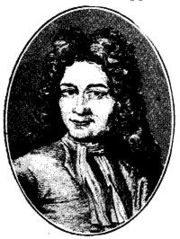
Johan Peringskiöld
Encyclopedia

Strängnäs
Strängnäs is a locality and the seat of Strängnäs Municipality, Södermanland County, Sweden with 12,296 inhabitants in 2005. It is located by Lake Mälaren and is the episcopal see of the Diocese of Strängnäs, a former Roman Catholic and present Lutheran Diocese, with the Strängnäs Cathedral, built...
and died in Stockholm
Stockholm
Stockholm is the capital and the largest city of Sweden and constitutes the most populated urban area in Scandinavia. Stockholm is the most populous city in Sweden, with a population of 851,155 in the municipality , 1.37 million in the urban area , and around 2.1 million in the metropolitan area...
.
His father was Lars Fredrik Peringer, a senior master at the gymnasium and his mother Anna Maria Mulich. He began his studies at Uppsala University
Uppsala University
Uppsala University is a research university in Uppsala, Sweden, and is the oldest university in Scandinavia, founded in 1477. It consistently ranks among the best universities in Northern Europe in international rankings and is generally considered one of the most prestigious institutions of...
in 1677 and he was an ardent student of the national antiquities. In 1680, he received a position at the newly established college of antiquities. He advanced to the position of clerk at the college in 1682, and he could then accompany Johan Hadorph
Johan Hadorph
Johan Hadorph was a Swedish director-general of the Central Board of National Antiquities. In 1667, he was appointed assessor at the government agency for antiquities, and in 1679, he became its director-general...
on scientific excursions in the countryside, during which he listed and made drawings of runestones, hill fort
Hill fort
A hill fort is a type of earthworks used as a fortified refuge or defended settlement, located to exploit a rise in elevation for defensive advantage. They are typically European and of the Bronze and Iron Ages. Some were used in the post-Roman period...
s, grave field
Grave field
A grave field is a prehistoric cemetery, typically of Bronze Age and Iron Age Europe.Grave fields are distinguished from necropoleis by the former's lack of above-ground structures, buildings, or grave markers.-Types:...
s and other prehistoric monuments.
In 1689, he was appointed deputy judge, and in 1693, he was knighted and received the name Peringskiöld as a sign of his nobility. In 1693, he was also appointed secretary of the college of antiquities, a task which was added to his work as a translator of Icelandic sources. In 1711, he left the work as translator to his son Johan Fredrik Peringskiöld
Johan Fredrik Peringskiöld
Johan Fredrik Peringskiöld was a Swedish translator.Johan was born in Stockholm, studied at Uppsala and was appointed as the successor of his father Johan Peringskiöld in 1712 as "translator antiquitatum" at the archive of antiquities. In 1719, he was appointed secretary and antiquarian, and he...
, and in 1719, he applied to be removed from his offices. The request was granted and he received instead the title of chancellor, and the following year, he died.
He assiduously created an extensive collection on his country's history, but some of it was destroyed in the fire of Stockholm Palace
Stockholm Palace
The Stockholm Palace is the official residence and major royal palace of the Swedish monarch. . Stockholm Palace is located on Stadsholmen , in Gamla Stan in the capital, Stockholm...
in 1697. What remains of his work is stored in the Swedish national archives and library. Like that of most historians of his time, his work lacked the scholarly criticism of modern days.

